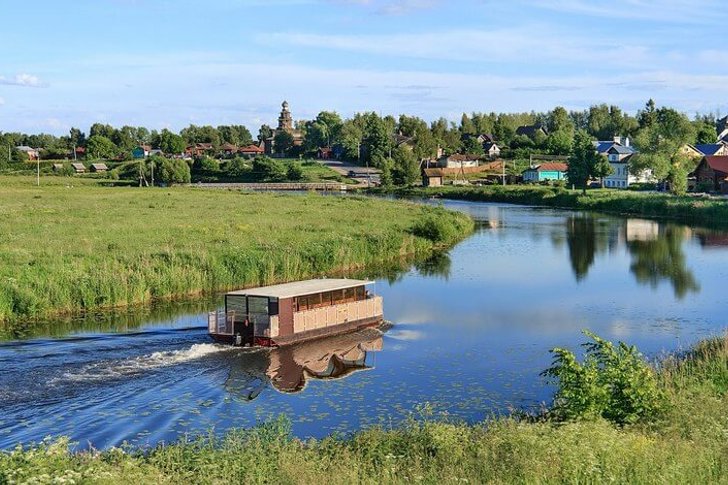Suzdal is one of the brightest, original and, of course, famous cities of the Golden Ring. All foreign tourists strive to get here on an excursion, since this is one of the few places in Russia (except for St. Petersburg and Moscow) that American, Chinese and European travelers know at least something about.
The infrastructure of Suzdal is developed at the most advanced level. Guests are welcomed by atmospheric boutique hotels, traditional taverns of Russian cuisine, various entertainments like riding a troika, folk festivals and folklore holidays. The architectural and historical heritage of the city consists of dozens of ancient temples and monasteries. Religious buildings dominate over civil ones - literally on every corner you can see some kind of church.
What to see and where to go in Suzdal?
The most interesting and beautiful places for walking. Photos and a short description.
- Suzdal Kremlin
- Mother of God-Nativity Cathedral
- Wooden St. Nicholas Church
- Assumption Church
- Churches of the Nativity and St. Nicholas
- Earth ramparts of the Suzdal Kremlin
- Monastery of Saint Euthymius
- Walls and towers of the Spaso-Evfimievskiy monastery
- Rizopolozhensky Monastery
- Vasilyevsky Monastery
- Alexander Monastery
- Intercession Monastery
- Peter and Paul and St. Nicholas churches
- Elias Church
- Church of Boris and Gleb in Kideksha
- Trading rows
- Resurrection and Kazan churches
- Tsarekonstantinovskaya and Sorrowful churches
- Entrance-Jerusalem and Pyatnitskaya churches
- Holy Cross Church
- Lazarevskaya and Antipievskaya churches
- Church of Cosmas and Damian on Jarunova Hill
- Smolensk and Simeonovskaya churches
- Kozmodemyanskaya and Holy Cross churches
- Museum of Wooden Architecture
- Shchurovo Settlement
- The Wax Museum
- Posad house
- Fire Tower
- Kamenka river
Suzdal Kremlin
The core of Suzdal and its oldest part, which presumably has existed since the 10th century. In the 11th-12th centuries, a fortress was erected here with an earthen rampart and walls about 1.5 km long. Inside were the princely court and the episcopal residence. The wooden architectural complex existed until the beginning of the 18th century, in 1719 all the buildings burned down. The Nativity Cathedral, Nikolskaya Church and Bishops' Chambers have survived to this day.
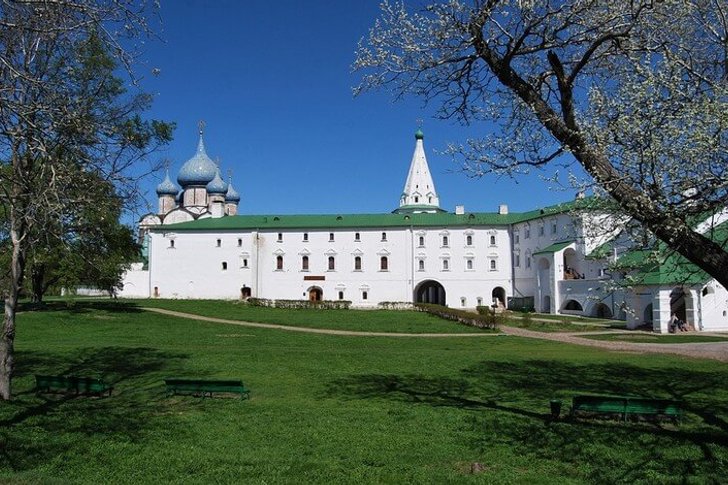
Mother of God-Nativity Cathedral
Temple of the XII century, an exceptional monument of Russian architecture, erected during the reign of Vladimir Monomakh. It was rebuilt twice, the last time after Suzdal was burned down by the Tatars in the 1440s. Because of this, different parts of the cathedral belong to different centuries: the lower one - to the 13th, the upper - to the 16th, the internal wall painting - to the 13th-17th centuries. The southern and western gates of the building are a true masterpiece of the applied art of Rus' during the Middle Ages.

Wooden St. Nicholas Church
The temple stands behind the Bishops' chambers on the territory of the Suzdal Kremlin. Initially, the church was built in 1766 in the village of Glotovo, Yuryevo-Polsky district, and moved to Suzdal in 1960 for better preservation of this architectural object. The building consists of two log cabins, reinforced on the basement. The gabled gabled roof is covered with boards, with a dome with a cross on top.
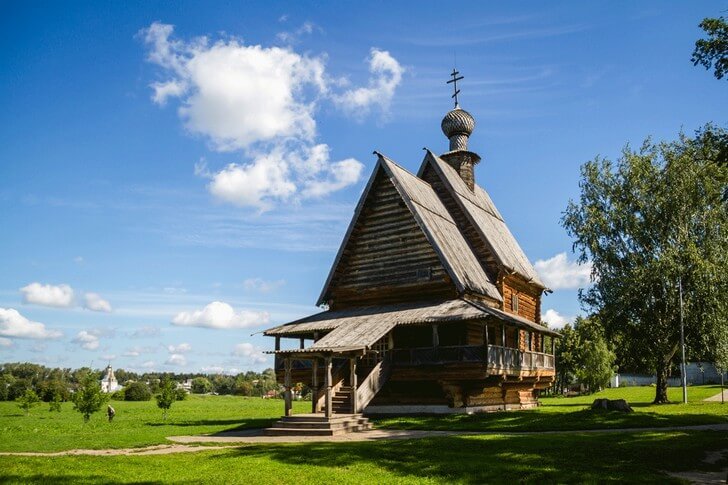
Assumption Church
A small church of the 17th century, erected in the manner of the Naryshkin baroque, presumably on the site of an older wooden building. Until 1917, the architectural ensemble included a belfry and two additional aisles, which were later destroyed. In 1958 the building was restored. In 2015, the relics of Arseny of Suzdal, who inspired Prince Pozharsky to march on Moscow during the Time of Troubles, were placed in the temple.

Churches of the Nativity and St. Nicholas
The Nikolsky Summer Church is the first religious building erected after the fire of 1719. It consists of a quadrangle and a semicircular apse adjacent to it on one side and a hipped belfry on the other. The warm Nativity Church was built at the end of the 18th century. With its appearance, it resembles an ordinary stone house, if it were not for the dome with a cross crowning the roof.
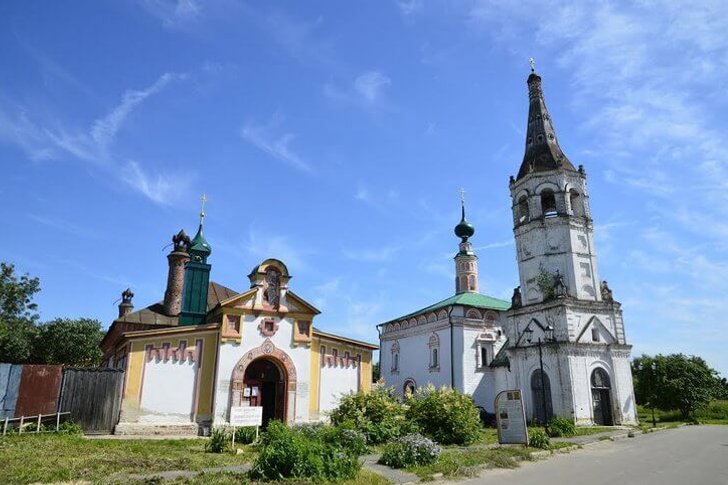
Earth ramparts of the Suzdal Kremlin
In ancient times, earthen ramparts were included in the system of defensive fortifications of the Suzdal Kremlin. Today, they are ordinary mounds overgrown with grass, which are of great historical value, although they do not look like anything special. The ramparts were built on the orders of Prince Vladimir Monomakh in the 11th century to further protect the settlement from frequent raids by the Kazan Khanate.
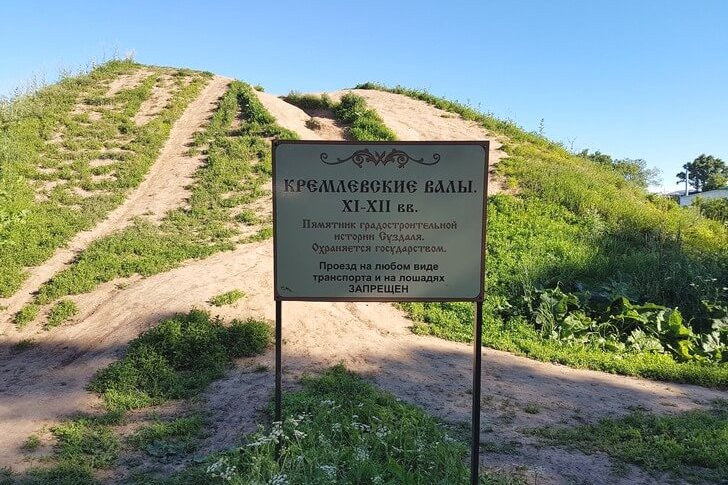
Monastery of Saint Euthymius
The male monastery, formed in the middle of the XIV century as a defensive fortress. The very first buildings of the architectural ensemble were made of wood; they have not survived to our time. The modern look of the complex was formed in the XVI-XVII centuries. Boyars, princes and tsars - Vasily III, Ivan the Terrible - donated large sums for the construction of stone churches. Since 1968, a museum has been located in the buildings of the monastery.

Walls and towers of the Spaso-Evfimievskiy monastery
The walls and towers of the monastery are best viewed from the side of the Kamenka River. They also run along Lenina and Spasskaya streets. It will take time to get around them around the perimeter. These buildings are a symbol of Suzdal, as they immediately catch the eye of travelers passing through the historical center of the city. Powerful walls could withstand any siege, but it so happened historically that they were never stormed.
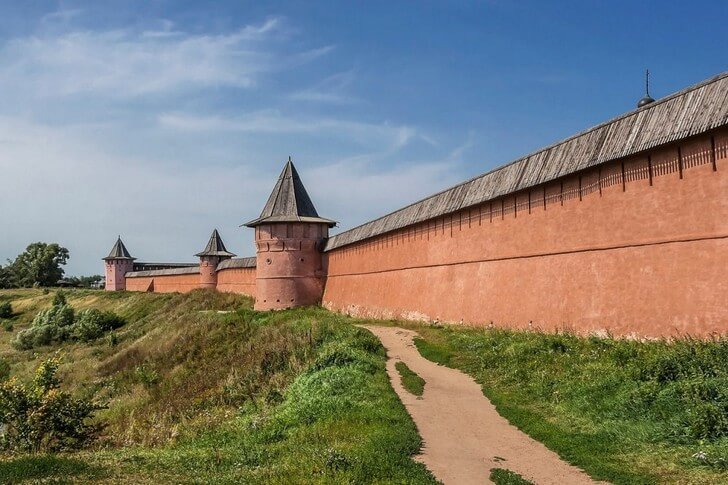
Rizopolozhensky Monastery
One of the most ancient monasteries of Rus', formed at the beginning of the 13th century. The first stone buildings appeared only after 3 centuries, earlier wooden buildings have not survived to this day. The architectural ensemble consists of the three-domed Rizopolozhensky Cathedral of the middle of the 16th century, the two-roofed Holy Gates of the 17th century, the Sretenskaya Refectory Church and the Reverend Bell Tower of the 19th century.
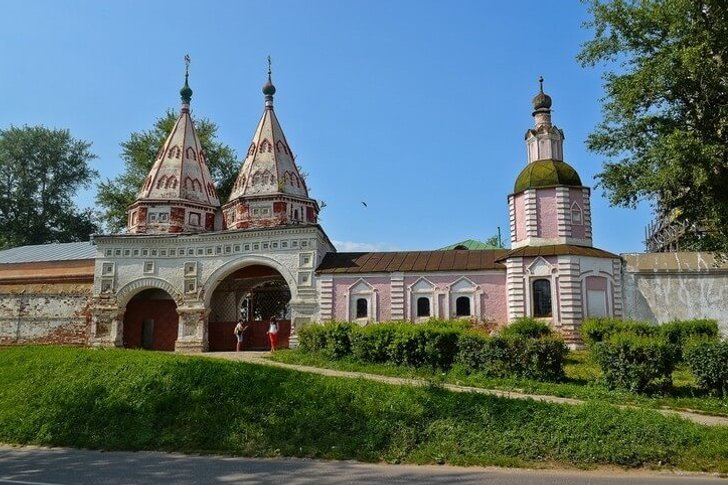
Vasilyevsky Monastery
The monastery stands almost on the outskirts of Suzdal. It was founded in the XIII century and at that time was located on the road to Kideksha. At first, the building performed defensive functions, then it was adapted for the life of the monastic community. Initially, the monastery was male, since 1916 - female. In the 1920s, the institution was closed, warehouses were placed on its territory. Since the 1990s, part of the monastery has again belonged to the Russian Orthodox Church.
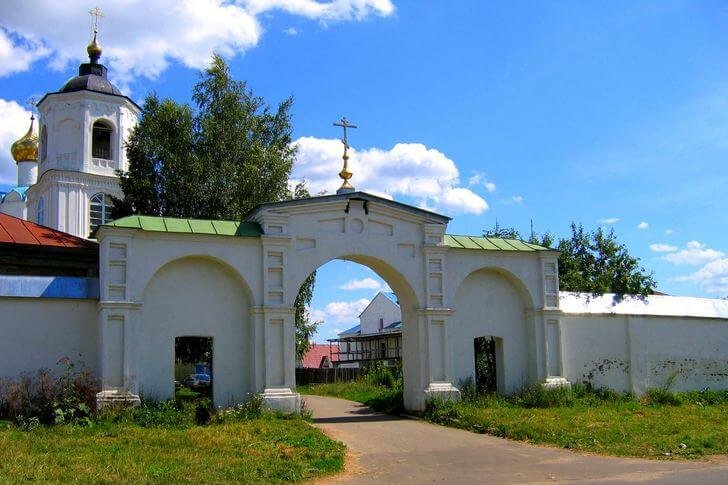
Alexander Monastery
According to legend, the monastery was founded by Prince Alexander Nevsky in 1240. Initially, it was for women - the inhabitants settled here, who remained orphans and widows after the invasions of the Kazan Tatars. In 1764, the monastery was abolished by order of Catherine II, the main cathedral was turned into a parish. Monastic life was revived only in 2006, the sisters were replaced by male monks.
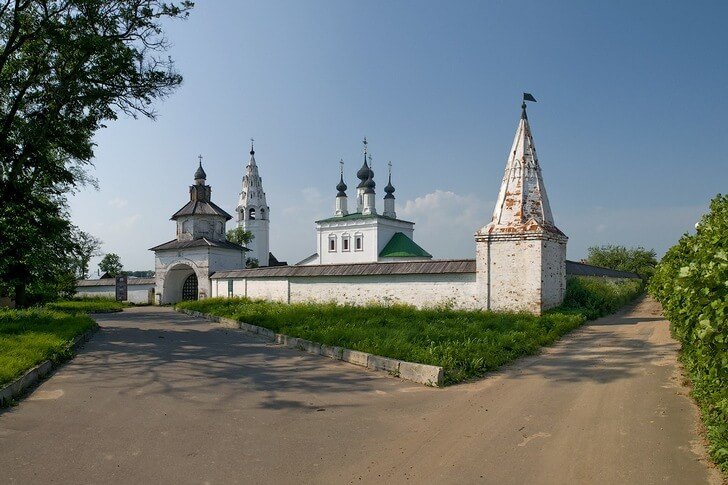
Intercession Monastery
The Intercession Monastery appeared in the 14th century in the northern part of Suzdal. It constantly developed and grew largely due to the fact that representatives of noble families came here for tonsure (of course, after donating large sums). By the 17th century, the monastery had become one of the largest on the territory of Vladimir-Suzdal Rus. Its architectural ensemble was formed by the 16th century.

Peter and Paul and St. Nicholas churches
The Peter and Paul Church was erected in 1694 next to the Intercession Convent. In architectural terms, it consists of two quadrangles, hoisted on top of each other, and crowned with five heads of domes. In 1712, at the expense of Evdokia Lopukhina, the ex-wife of Peter the Great, the winter St. Nicholas Church was built next to him, which is distinguished by a rather modest appearance. To date, both temples have returned to their original appearance.

Elias Church
The temple is located on one of the steep bends of the Kamenka River. The stone building was erected in 1744, earlier its place was occupied by a wooden building, transferred from another part of the settlement. The church was badly damaged in the 20th century, the bell tower and the refectory were completely demolished. Restoration began in the 1970s but ended only in the 2000s. During this time, it was possible to completely recreate the original appearance of the structure.
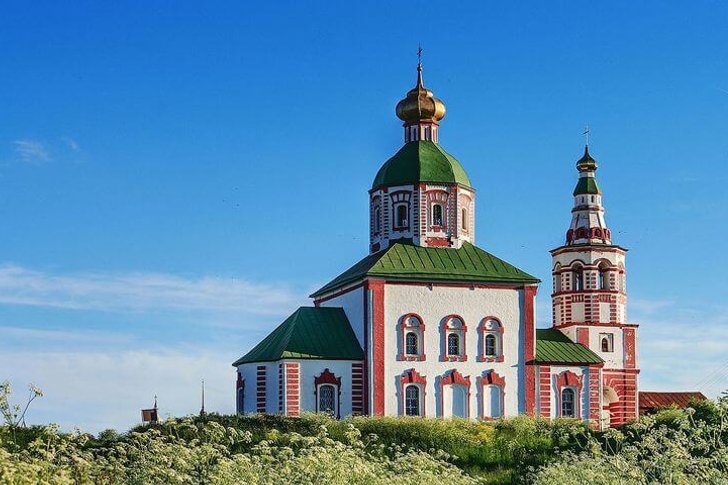
Church of Boris and Gleb in Kideksha
An ancient temple, a valuable and rare monument of church architecture of the pre-Mongol era. It was erected in the middle of the XII century during the reign of Yuri Dolgorukov. In the XVI-XVII centuries, the church was significantly rebuilt, completely dismantling some of the walls, but, nevertheless, retaining many of the original elements. The building has been included in the UNESCO World Heritage List. Nowadays, there is a museum on its territory.
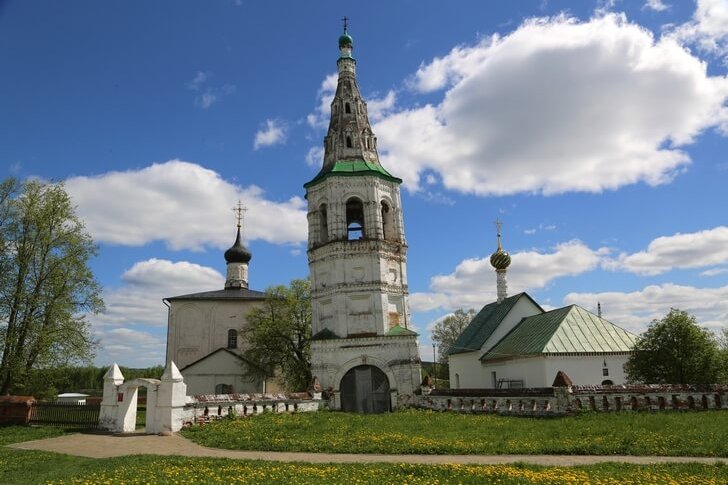
Trading rows
Gostiny Dvor in the Empire style, built at the beginning of the 19th century. It was designed for 100 merchant shops, which later turned into full-fledged stores. The complex is the most impressive monument of civil architecture in Suzdal. It is the center of trade and tourist life, as tourists often stop here to buy souvenirs, taste mead or just stroll along the long galleries.

Resurrection and Kazan churches
Not far from the main city square stands the Church of the Resurrection, built of stone in 1720 (originally it was wooden). The building is a two-pillar temple of a cubic shape, its base is a powerful quadrangle, decorated with corner pilasters. The Kazan Church was built nearby in 1739; together with Voznesenka, it formed a single architectural ensemble.
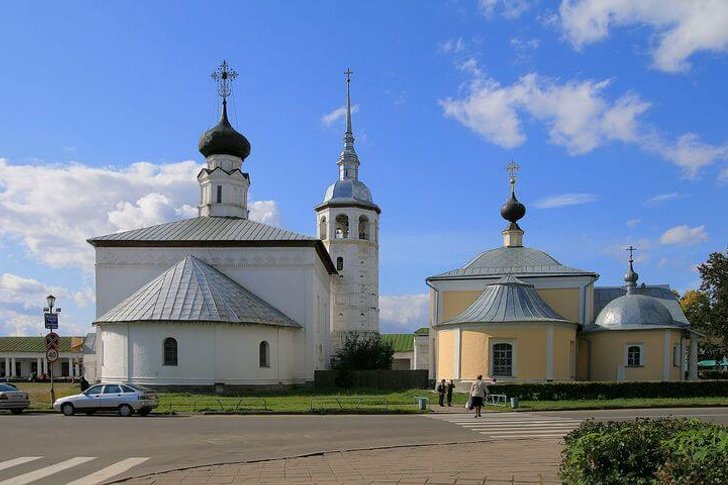
Tsarekonstantinovskaya and Sorrowful churches
The first mention of the Tsar Konstantinovsky temple dates back to the beginning of the 17th century. A century later, it was rebuilt from stone, and it became the last five-domed religious building in Suzdal. The Winter Sorrowing Church, in addition to Tsarekonstantinovskaya, appeared in the middle of the 18th century. The architecture of its bell tower is considered quite familiar to Suzdal - the belfry is made in the form of a concave tent.

Entrance-Jerusalem and Pyatnitskaya churches
Another pair complex, consisting of two churches. It should be noted that the construction of two temples side by side - summer and winter - was a very common practice in Suzdal. The appearance of the Entrance-Jerusalem and Pyatnitskaya churches differs quite significantly: one is made in the form of a classic quadrangle topped with five domes, the second has only one central domed structure, fixed on the roof in the form of a semicircle.

Holy Cross Church
The temple is located in the northern part of Gostiny Dvor. It was erected in 1770 in gratitude for getting rid of the terrible plague that raged in Suzdal in 1654-55. The building differs from other churches in the city in that if you look at it from opposite sides, it looks completely different. It seems that you are looking at two different buildings.
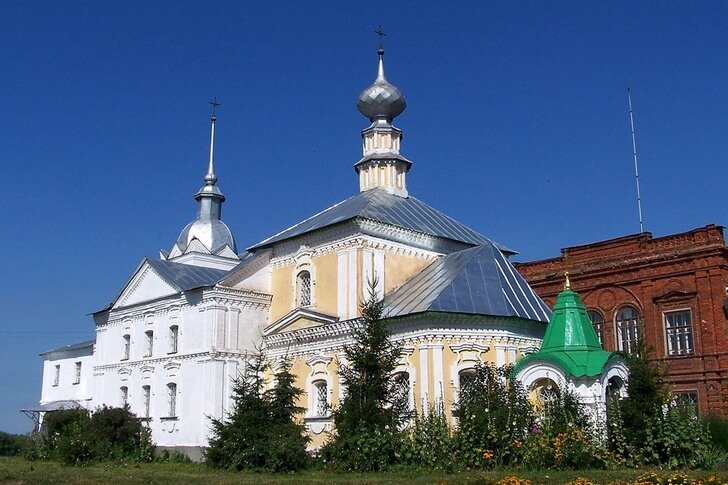
Lazarevskaya and Antipievskaya churches
Both churches were built with a gap of a hundred years. According to the established tradition, one church was cold (Lazarevsky), the other was warm, intended for worship in winter and during the chilly off-season. The bell tower of the Antipievskaya Church has a very original appearance with a roof in the form of a concave tent and bright exterior painting. It is believed that it was built before the main building.
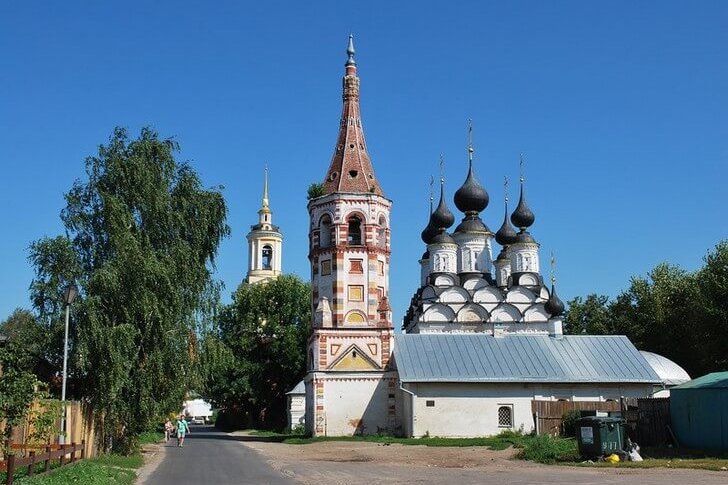
Church of Cosmas and Damian on Jarunova Hill
An 18th century Orthodox church built on a low hill on the banks of the Kamenka River. According to unconfirmed reports, earlier in its place was the monastery of the same name, from which the only wooden church remained by the 17th century. The building is located in a very picturesque place and looks spectacular against the backdrop of a winding river bed. Until 1917, the territory was surrounded by a stone fence.
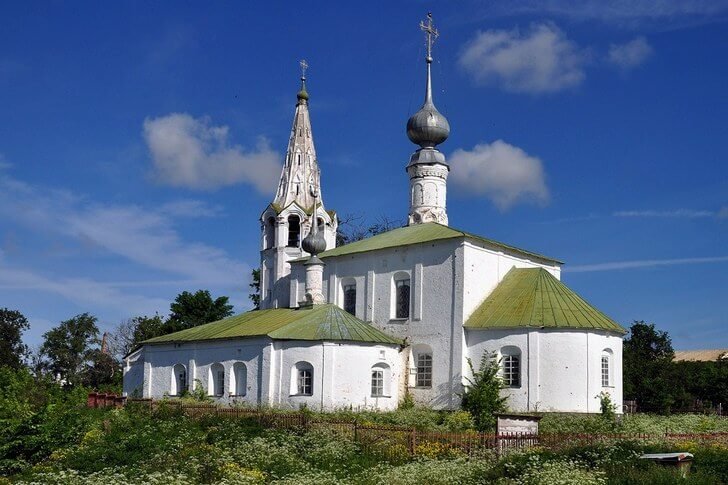
Smolensk and Simeonovskaya churches
The Smolensk Church was built in 1706 not far from the corner tower of the monastery. The building is located on the road that takes travelers to Suzdal from Yaroslavl. After 40 years, the Simeon Church was built - winter. The classical style bell tower was added later, at the turn of the 19th century. Thus, the architectural ensemble does not look like a single concept and bears the features of different eras.
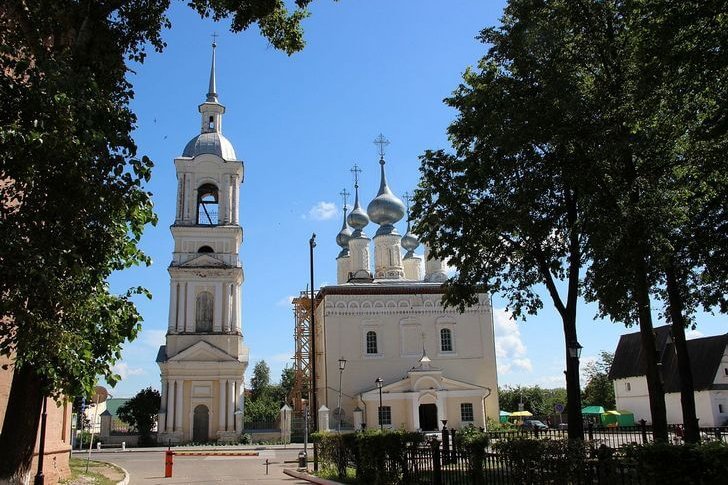
Kozmodemyanskaya and Holy Cross churches
Another ensemble of warm and cold temples, which is located at the maximum distance from the center. Perhaps that is why its architecture looks rather laconic, and the restoration has not yet been completed. The buildings were built in the XVII-XVIII centuries, they are visible from the side of the ring road that goes around Suzdal (if you go from Vladimir and Ivanovo to Moscow or in the opposite direction).
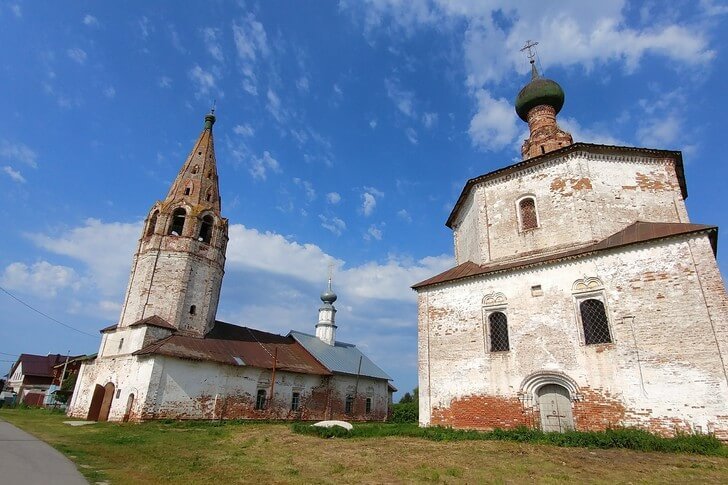
Museum of Wooden Architecture
Museum complex in the open air, which contains monuments of wooden architecture of the XVII-XIX centuries. On its territory you can see the huts of a peasant and a wealthy merchant, as well as churches built without the use of nails. In addition to residential buildings and temples, there are various outbuildings: barns, mills, sheds, wells. The museum hosts a summer cucumber festival.
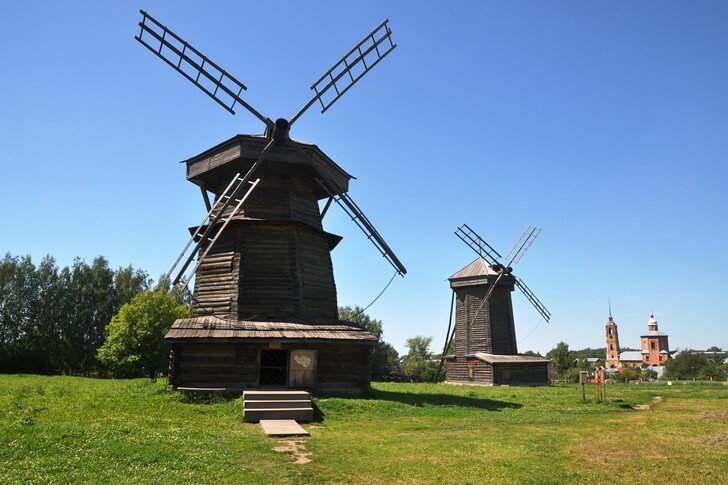
"Shchurovo Settlement"
Museum located within the HELIOPARK Suzdal hotel complex, which was created on the basis of the scenery for the film "The Tsar" by P. Lungin. It is a reconstruction of a Slavic settlement of the 10th century. A variety of interactive programs are provided for visitors. Here you can learn archery, ride a horse, do garden work or even milk a cow.
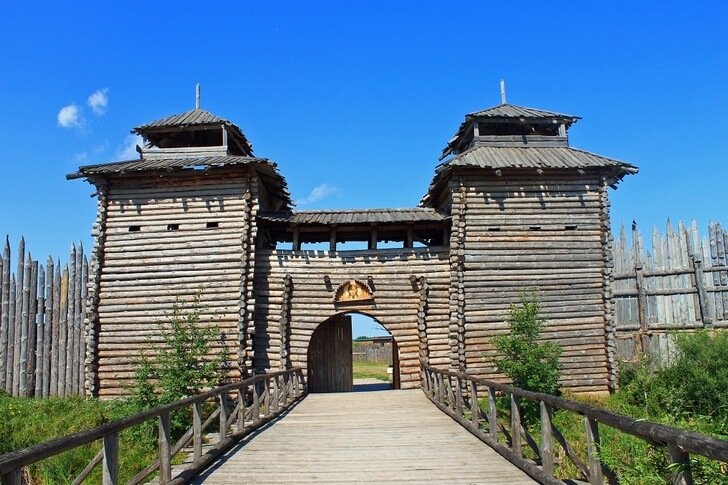
The Wax Museum
The Suzdal Wax Museum grew out of a small exhibition held in the 1990s in Sokolniki Park. For quite a long time, the exposition traveled all over the world and Russia, as a result, it settled in Suzdal. At the same time, it is developing, new exhibits continue to be produced. Most of the collection is personalities of Russian history: tsars, writers, politicians, military leaders.

Posad house
Until the 17th century, stone dwellings were a rarity in Russian cities, since wood was much cheaper, and forests were everywhere. Some especially wealthy citizens could still afford to build stone mansions. One of these structures in Suzdal is the Posad House, built by an unknown architect. In the 17th century it was inhabited, then a tavern was opened on its territory. It has been a museum since the 1970s.
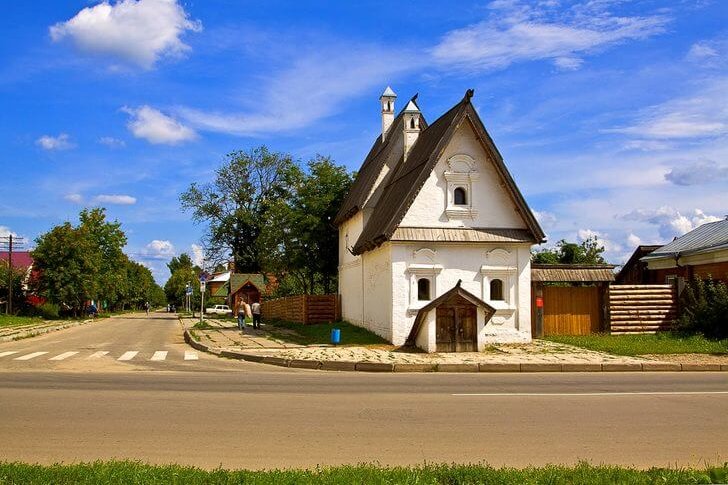
Fire Tower
The tower was erected in the 1890s for the fire brigade, which had been operating in the city since 1864. By the early 2000s, the tower was in a rather deplorable state. In order to preserve the architectural monument and preserve its functionality, quite serious restoration work was carried out, restoring the original appearance of the tower according to old drawings and drawings.
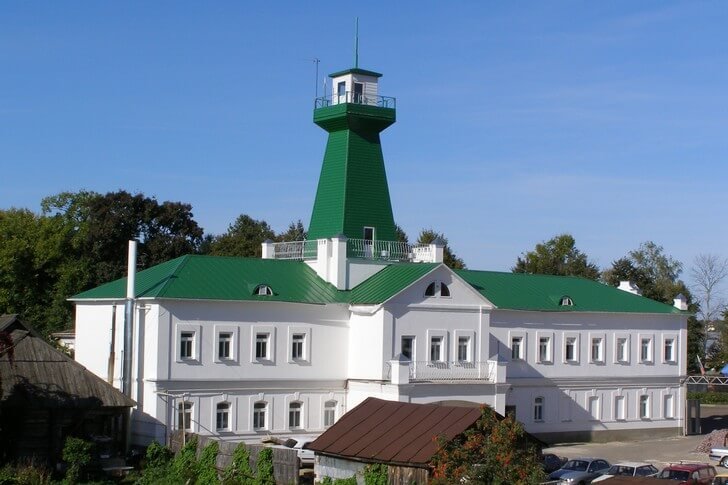
Kamenka river
Kamenka is a tributary of the Nerl River. It is a small and not intended for navigation water artery with a length of about 50 km, while it is very convenient for small river transport: boats, kayaks. It flows through Suzdal, many city sights are located on its high banks, including churches, walls and towers of the Spaso-Evfimievsky monastery.
